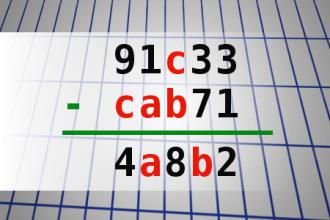Find number abc
If 91c33 - cab71 = 4a8b2 find number abc. Multiple solutions may exist.Correct answers: 44
The first user who solved this task is Djordje Timotijevic.
#brainteasers #math

Funny Christmas cracker jokes
What do they sing at a snowman's birthday party?
Freeze a jolly good fellow
Why does Santa have three gardens?
So he can 'ho ho ho'!
What does Miley Cyrus have at Christmas?
Twerky!
Why did Santa's helper see the doctor?
Because he had a low "elf" esteem!
Who is Santa's favorite singer?
Elf-is Presley!
What do Santa's little helpers learn at school?
The elf-abet!
Why are Christmas trees so bad at sewing?
They always drop their needles!
Did Rudolph go to school?
No. He was Elf-taught!
How do snowmen get around?
They ride an icicle!

